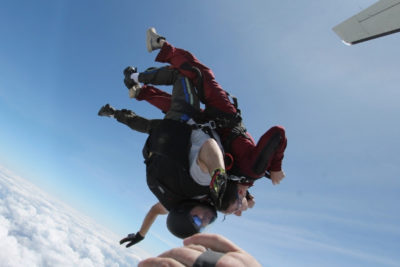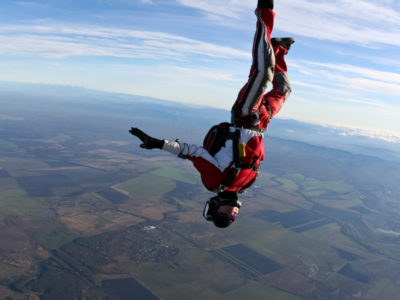Skydiving is all about pushing boundaries, both physical and mental. After all, humans were never meant to fly through the air in the first place! And in that spirit of challenge, skydivers have been taking the sport to new highs, literally, since the day the first jump was made. That’s why of all the skydiving world records, the highest skydive is the one that continues to dazzle jumpers and non-skydivers alike.
While the current highest record is incredible, it’s not the only one that deserves mention. Many people have risked life and limb throughout history to push the upper altitude of skydiving higher, and they’re all worth talking about.
Altitude records can also be broken down into different categories: highest skydive in the world, longest freefall, and even most skydives in 24 hours (which currently sits at 640 jumps!). There are many different ways to enjoy the highest points in the sky, and skydivers do their best to find them all.
The Highest Skydive Records Through the Ages
As you might have guessed, skydivers are a little bit altitude-obsessed. Many of us get into the sport because we can’t get enough freefall, and higher altitude equals more of that sweet hang time.
André-Jacques Garnerin
The first-ever highest skydiving record belongs to whoever else but the man who made the first jump! The first skydive was made by André-Jacques Garnerin from a hydrogen balloon, 3,200 feet above Paris in 1797. Thank you for centuries of fun, Monsieur Garnerin!
Alan Eustice
The person with the highest skydive ever (at least until the next person comes along and breaks it) is a man who served as the first Senior Vice President for Knowledge at Google. So what is the highest skydive to date? Alan Eustice jumped from an unfathomable 135,890 feet!!
Felix Baumgartner
How long did Felix Baumgartner fall? Before Alan, the highest skydive jump was from 127,850 feet. This record skydive was sponsored by the ubiquitous Red Bull company and received worldwide attention and fanfare. And for good reason! Felix actually broke the sound barrier during his freefall!
Joe Kittinger
Perhaps one of the more impressive records, because it was done before modern technology, is the 102,800 feet that Joseph Kittinger jumped from in 1960. He had set other altitude records before that one, but the 1960 record held the longest. And, if you can believe it, the longest skydive on record still stands from Joe’s jump in 1960 at 4 minutes and 36 seconds!
As you can see, skydivers have always been chasing that high, literally and figuratively!
 Bonus Fact: Most skydivers actually keep a running log of their own personal freefall record
Bonus Fact: Most skydivers actually keep a running log of their own personal freefall record
From Static Line to Freefall
In the early days of sport jumping, skydivers completed what are known as static line jumps. Their parachute would be attached directly to the airplane (or held by someone still inside the plane) and would deploy as they left the aircraft. This didn’t leave much time for freefall, and these jumpers never even reached terminal velocity. Exit altitude was much lower than today because there was no need for the extra time of freefall.
Throughout the ’70s, skydivers began jumping from higher altitudes and using altimeters and timers to know when to deploy their parachutes. Jump altitudes became increasingly higher until they reached the 10,000 feet and above mark we’re at today. This also created a need for student programs so that new jumpers could safely learn how to fly their bodies in the air.
Science and Technology Behind High-Altitude Skydives
Higher-than-normal skydives require extra planning and equipment. That’s why every single skydive doesn’t happen from the stratosphere (trust us, if we could, we totally would). And the higher the skydive, the more planning is required.
The higher you go into the atmosphere, the less oxygen there is to breathe. Oxygen deficiency, also known as hypoxia, causes confusion, headache, anxiety, and even loss of consciousness. To avoid the risk of developing hypoxia, skydivers will breathe oxygen during the ride to altitude, or sometimes even during freefall.
There are actually rules and requirements set out by the United States Parachute Association (USPA) that help skydivers prepare for high altitude jumps depending on how high they are jumping from:
For intermediate-altitude jumps (15,000-20,000 feet MSL):
- Participants should hold at least a USPA B license and have made 100 jumps.
- All participants should put on masks and begin breathing oxygen at 8,000 feet MSL. Jumpers should stay on oxygen for as long as possible, removing their masks at the “climb out” or “exit” signal.
For high-altitude jumps (20,000-40,000 feet MSL):
- Participants should hold a USPA C license and have made at least one jump from 15,000 feet MSL or below using the same functioning bailout oxygen system.
- All participants should put on masks and begin breathing oxygen at 8,000 feet MSL. Two minutes prior to exit, skydivers should activate bailout bottles and disconnect from the aircraft oxygen system.
- Additionally, all skydivers should pre-breathe 100% oxygen under the supervision of the oxygen monitor for 30 minutes before takeoff when the goal altitude is above 25,000 feet MSL.
For extreme-altitude jumps (40,000 feet MSL and higher):
- Participants should hold a USPA D license and have made at least two jumps from below 35,000 feet MSL using the same functioning bailout oxygen and pressure systems.
- Standard oxygen procedures are not established but must be developed for the specific mission and equipment.
 High-altitude jumps are no joke! Safety considerations must be ramped up, and preparation is key to a successful jump, regardless of altitude.
High-altitude jumps are no joke! Safety considerations must be ramped up, and preparation is key to a successful jump, regardless of altitude.
The Future of High-Altitude Skydiving
With all this information, you might wonder: What is the highest skydive allowed? What is the longest free fall distance allowed? There are technically no blanket rules around altitude and freefall distance. The only limitation is technology and skydiver courage. And as technology improves, we’ll continue to see brave skydivers use those innovations to push the sport farther and higher.
Fun fact: Where is the highest skydiving place in the world? Skydivers actually jump over Mount Everest!
Are you ready to set your very own skydiving height record? Book your tandem today and taste some extreme altitude! Blue skies!!
Copyright © 2025, Skydive Monroe, All Rights Reserved.
DropZone Web Design & Marketing by Beyond Marketing, LLC



